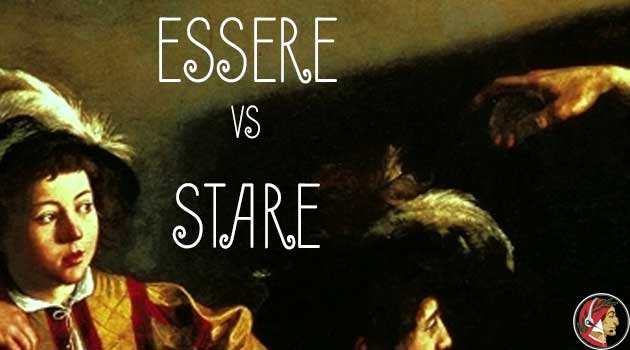Essere and Stare are very important Italian verbs. It’s easy to get lost, since sometimes they both mean “to be”
This is a very basic explanation on the difference between essere and stare, two very important Italian verbs. if you want to know more, please book a Zoom class at the bottom of this page,
il verbo STARE
| – | presente | imperfetto |
|---|---|---|
| io | sto | stavo |
| tu | stai | stavi |
| lui / lei | sta | stava |
| noi | stiamo | stavamo |
| voi | state | stavate |
| loro | stanno | stavano |
The use of two important Italian verbs, essere and stare, can generate some confusion with English speakers.
To be and to stay roughly correspond to essere and stare, but in some cases they do not. You probably learned in your first Italian class that “How are you?” is “Come stai (tu)?”.
- Sto bene / Sto male.
- Sono stanco / Sono felice.
We use adverbs with stare (bene, male) and adjectives with essere (stanco, felice) for expressing a physical or mental condition. Stare in this case is very close to essere.
Stare as to be in a place
- Il cane sta fuori. – The dog stays outside.
- Il cane è fuori. – The dog is outside.
In the first sentence I say that the dog is usually outside, so it needs to stay out; in the second, the dog is outside now. Stare indicates “being” in a place for an amount of time, while essere is just now.
As a side note, quite relevant, in Central and Southern Italy, stare is used quite frequently in sentences where we should use essere. People often say:
- Federico adesso sta a Firenze (instead of è a Firenze).
- Mia madre sta parecchio arrabbiata (instead of è arrabbiata).
- Ci sta un una macchina davanti a casa (instead of c’è).
Stare in a progressive sentence
A rather confusing difference between English and Italian is in the construction of the progressive form:
“I am doing…” VS “(Io) Sto facendo…”. To be (essere) in English, to stay, stare in Italian.
- Mario sta studiando.
- Mario stava studiando quando l’ho chiamato.
Of course we can build progressive sentences with other tenses.
Once you learn the rule, it’s quite easy to remember it.
Finally, a very important and quite overlooked oddity of the Italian language. The past participles of essere and stare (been and stayed) are the same: “stato”.
Io sono stato can mean both “I have been” and “I have stayed” (or I was and I stayed).
All the reasons above can explain why essere and stare are so connected, similar and at first confusing. Apparently the big part of the confusion comes from the use of stare. Let’s look at a few examples.
Stare for expressing behavior
- Sto sempre sveglio di notte. – I am always awake at night.
- I bambini non stanno mai zitti. – Children are never silent.
Stare as imperativo
- Stai zitta! – Be silent!
- State attenti alla lezione. – Stay focused during the the class.
Stare for expressing feelings
- I miei genitori stanno bene. – My parents are fine.
- Tua madre sta in ansia per te. – Your mother is worried for you.
Stare in a place for an amount of time
- Sono a casa. (I’m home now)
- Sto a casa. (I stay home, I won’t go out)
In Southern Italy, people would say “sto a casa” to indicate “I’m home now” instead of “sono a casa”. So you don’t have to worry, Italians are confused too.
Grazie per avere letto questo articolo. Se avete domande, fatemi sapere. Alla prossima.
Continua…
Dante-Learning
Start Your Italian Language Journey Now

Login or subscribe with one click and keep studying this lesson for free.
Try the quiz at the bottom of the page.


Not all of Southern Italy uses stare instead of essere. In Sicily and in Calabria where dialects classified as Sicilian are spoken, it is not. In fact essere is used at times where stare would be in Italian – but that’s another story.
Also, in colloquial Italian stare is also used instead of abitare.
Ex: Dove sta Roberto? Sta a Roma ma adesso è a Milano.
As I wrote at the beginning, “in Central and Southern Italy, stare is used quite frequently in sentences where essere would normally be expected.” It’s not a black and white rule. The same goes for the passato remoto, which is less common in Neapolitan dialects than in Sicilian.
The use of stare in Neapolitan dialects also differs from the rest of the South. Northern and Southern Calabria are quite different as well, with the region being linguistically split into at least two areas, not to mention the influence of Albanian and Greek minorities.
In Northern Italy, on the other hand, “stare” is never used in place of “abitare”.
Thank you for your useful explanations. Does ‘stare’ also mean something like our English ‘to look?’ Maria, oggi stai molto bene. Maria, you look nice today.
Yes. When “stare” is followed by the adverbs “bene” or “male”, we talk about a condition, visible or abstract. It applies to the appearance: “Maria, oggi stai bene” or “Maria, questo vestito TI STA bene”; but also, for example, wealth: “Maria non è ricca ma sta bene”. Wealthy in Italian is “benestante”. Ciao.